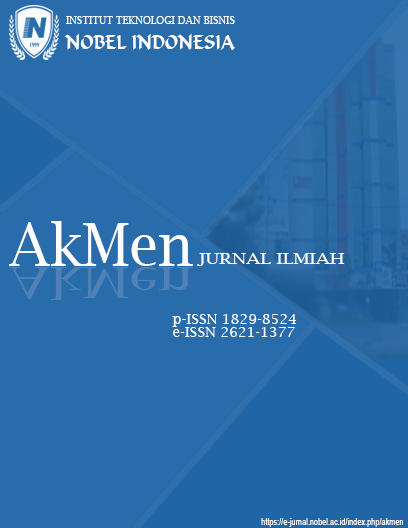PEMANFAATAN ARTIFICIAL INTELLIGENCE DALAM VISUALISASI DAN INOVASI PRODUK KULINER: DAMPAKNYA TERHADAP PERSEPSI DAN PREFERENSI KONSUMEN
DOI:
https://doi.org/10.37476/akmen.v22i2.5316Keywords:
Artificial Intelligence, Visualisasi Makanan, Inovasi Kuliner, Persepsi Konsumen, Minat BeliAbstract
The advancement of Artificial Intelligence (AI) has significantly transformed the culinary industry, particularly in food visualization and product innovation. Visual aesthetics play a crucial role in shaping consumer perceptions and influencing purchase decisions. This study investigates how AI-generated food imagery affects consumer perceptions of quality and purchase intention, and explores consumer responses to AI- assisted culinary product innovations. The research employs a quantitative experimental method with an A/B test design, comparing consumer reactions to AI-generated food images and authentic food photographs without disclosing their sources. Additionally, a consumer survey evaluates perceptions of AI-driven culinary innovations. Findings indicate that AI-generated visuals significantly enhance perceived product quality and attractiveness. However, when consumers are aware that the visuals are AI-generated, purchase intention decreases due to concerns over product authenticity. Despite this, consumers express interest in culinary innovations resulting from human-AI collaboration, provided product safety and authenticity are maintained.
References
Buechel, E. C., & Janiszewski, C. (2014). Aesthetic experiences and consumer behavior: The role of visual harmony. Journal of Consumer Psychology, 24(2), 169–182.
Buechel, E. C., & Janiszewski, C. (2014). Aesthetic experiences and consumer behavior. Journal of Consumer Research, 41(2), 376–393.
Chen, L. & Lee, M. (2022). AI in Visual Consumer Experience. Singapore: Springer Nature.
Zhou, Y. (2021). Digital Aesthetics in Food Marketing. London: Routledge.
Chiu, H.-C., Hsieh, Y.-C., & Kuo, Y.-C. (2014). How to align your brand stories with product innovation. Journal of Business Research, 67(2), 164–170.
Choi, Y. & Andersson, T. (2020). Creativity in Food Branding. London: Routledge.
Fishbein, M., & Ajzen, I. (1975). Belief, Attitude, Intention and Behavior: An Introduction to Theory and Research. Addison-Wesley.
Gaggioli, A. & Valsasina, R. (2024). The Augmented Mind: Human-AI Co-Creation in Culinary Arts. Milan: Springer.
Hekkert, P. (2006). Design aesthetics: Principles of pleasure in design. Psychology Science, 48(2), 157–172.
Kotler, P., & Keller, K. L. (2016). Marketing Management (15th ed.). Pearson Education.
Kwon, S. (2023). The Psychology of Food Design. Seoul: Korea University Press.
Lee, K., & Chow, P. S. (2019). Artificial intelligence and food innovation: Exploring consumer perceptions. Journal of Food Research, 8(3), 115-125.
Liu, T. (2023). AI and Visual Persuasion. Tokyo: IGI Global.
Martinez, P. & Gómez, R. (2021). Consumer Acceptance of Emerging Food Technologies. Barcelona: Elsevier.
McCormack, J., Gifford, T., & Hutchings, P. (2019). Autonomy, Authenticity, and Intention in Computer-Generated Art. Computational Creativity Journal, 7(1), 38–52.
Nakamura, K. & Tan, J. (2022). Artificial Intelligence and Creative Food Design. Kyoto: FoodTech Press.
Norman, D. & Alvarez, M. (2021). Designing Emotionally Intelligent Food Products. Boston: MIT Culinary Lab Series.
Norman, D. A. (2004). Emotional Design: Why We Love (or Hate) Everyday Things. Basic Books.
Nørskov, S., & Rask, M. (2021). Trust and artificial intelligence: Consumer perceptions in the digital food environment. Computers in Human Behavior, 123, 106872.
Peter, J. P., & Olson, J. C. (2010). Consumer Behavior and Marketing Strategy. McGraw-Hill Education.
Pine, B. J., & Gilmore, J. H. (1999). The Experience Economy: Work Is Theater & Every Business a Stage. Harvard Business Press.
Reyes, M. & Mahapatra, S. (2022). Behavioral Models in Digital Consumption. New Delhi: Sage.
Rogers, E. M. (2003). Diffusion of Innovations (5th ed.). Free Press.
Spence, C., Velasco, C., & Knoeferle, K. (2016). A large sample study on the influence of visual aesthetics on food evaluation. Appetite, 96, 17–24.
Spence, C., Velasco, C., & Knoeferle, K. (2016). Aesthetic plating: Studying the effect of arrangement, balance, and color on liking and willingness to pay for food. Appetite, 104, 205–213.
Sun, M., Du, Y., & He, X. (2022). The role of AI-driven innovation in enhancing product creativity and consumer curiosity. Journal of Product Innovation Management, 39(2), 245–259.
Sun, Y., Li, Q., & Wang, J. (2022). Artificial intelligence in the food industry: Applications, challenges, and future perspectives. Trends in Food Science & Technology, 119, 630–641.
Tussyadiah, I. P., & Miller, G. (2019). Perceived impacts of artificial intelligence and responses to positive behavior change: A grounded theory approach. Journal of Travel Research, 58(6), 965–978.
Verganti, R. (2009). Design-Driven Innovation: Changing the Rules of Competition by Radically Innovating What Things Mean. Harvard Business Press.
Verganti, R. (2020). Meaningful Innovation: Beyond Function and Form. Milan: Politecnico di Milano Press.
Wansink, B. (2010). From mindless eating to mindful eating. Journal of Consumer Psychology, 22(1), 27–34.
Wansink, B. (2010). Mindless Eating: Why We Eat More Than We Think. Bantam Books.
Zhang, R. & Hsu, C. (2020). Consumer Psychology in Digital Media. New York: Palgrave Macmillan.
Downloads
Published
How to Cite
Issue
Section
License
Copyright (c) 2025 AkMen JURNAL ILMIAH

This work is licensed under a Creative Commons Attribution-NonCommercial-ShareAlike 4.0 International License.
Penulis yang menerbitkan pada Jurnal Ilmiah AkMen menyetujui persyaratan berikut:
- Penulis memiliki hak cipta dan memberikan hak Jurnal Ilmiah AkMen untuk publikasi pertama dengan karya yang secara bersamaan dilisensikan di bawah Lisensi Atribusi Creative Commons (CC BY 4.0) yang memungkinkan orang lain untuk berbagi (menyalin dan mendistribusikan kembali materi dalam media atau format apa pun) dan beradaptasi (mencampur) , mentransformasikan, dan membangun di atas bahan) karya untuk tujuan apa pun,
- Penulis dapat membuat perjanjian kontrak tambahan yang terpisah untuk distribusi non-eksklusif versi jurnal, yang diterbitkan dari karya tersebut (misalnya, mempostingnya ke repositori institusional atau menerbitkannya dalam sebuah buku), dengan pengakuan atas publikasi awalnya di Jurnal Ilmiah AkMen
- Penulis diizinkan dan didorong untuk memposting pekerjaan mereka secara online (misalnya, dalam repositori institusional atau di situs web mereka) sebelum dan selama proses pengajuan, karena dapat menyebabkan pertukaran yang produktif, serta kutipan yang lebih awal dan lebih besar dari karya yang diterbitkan.





1.jpg)






